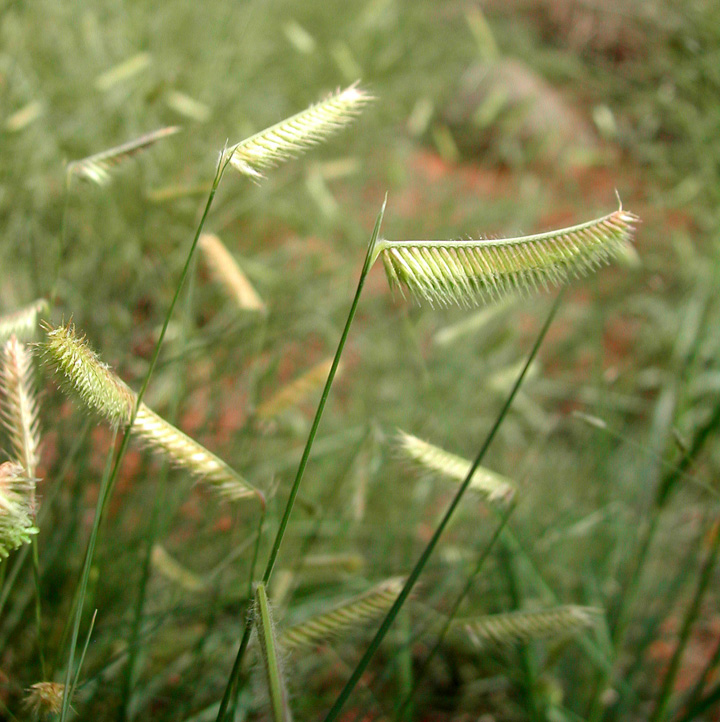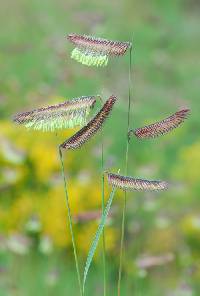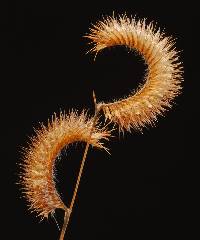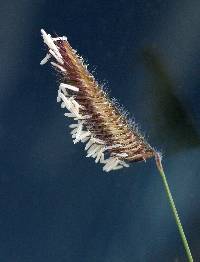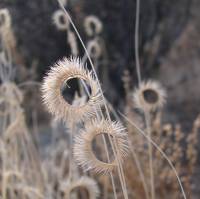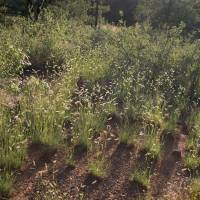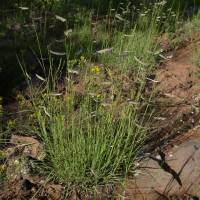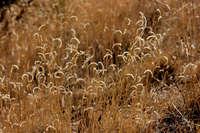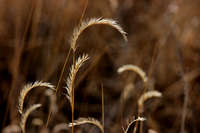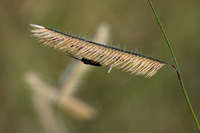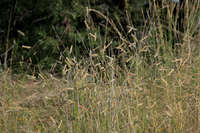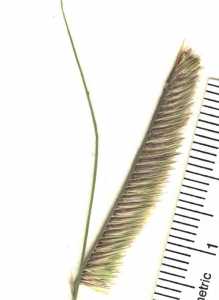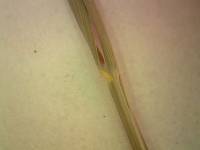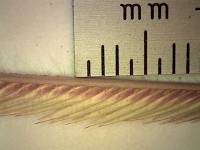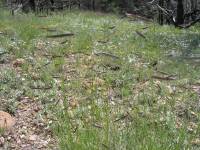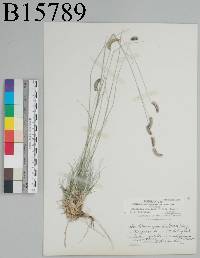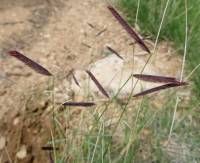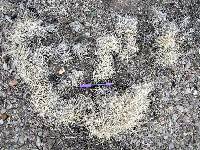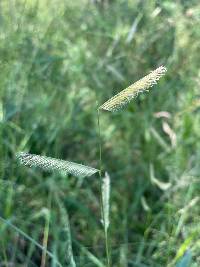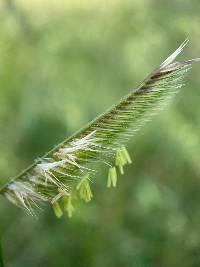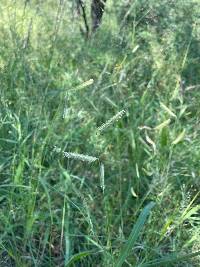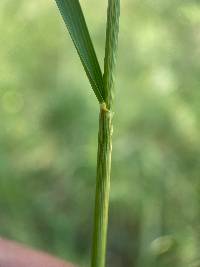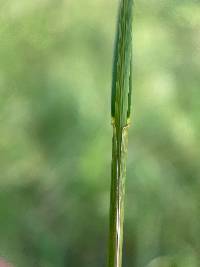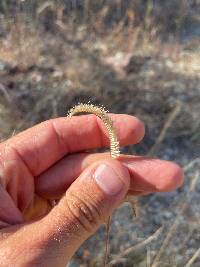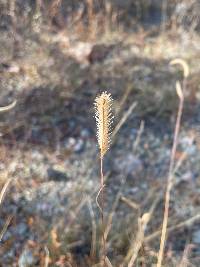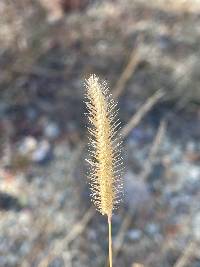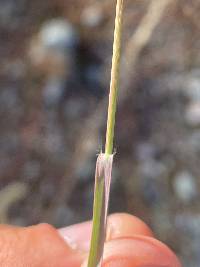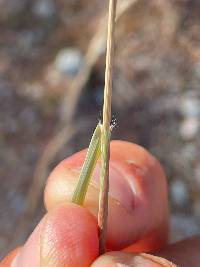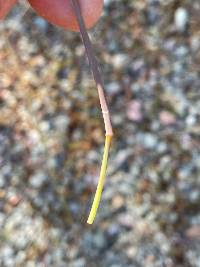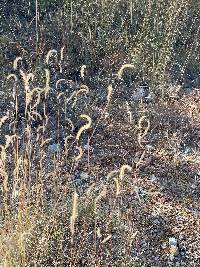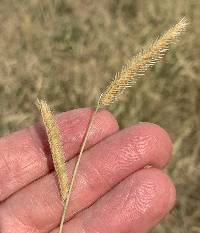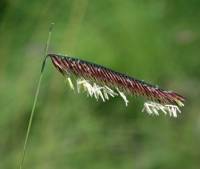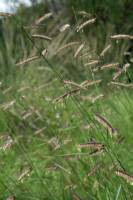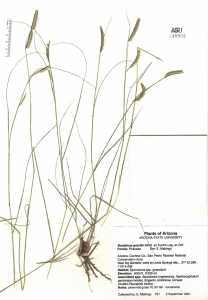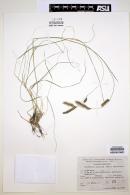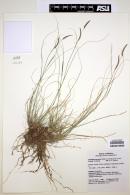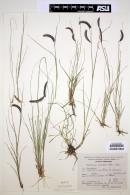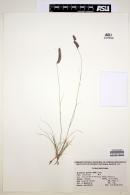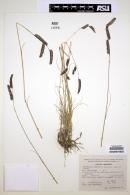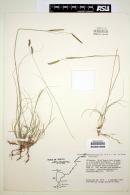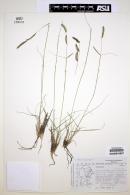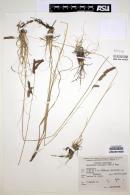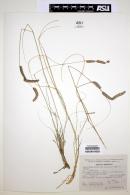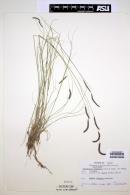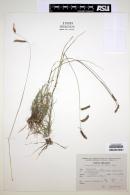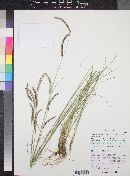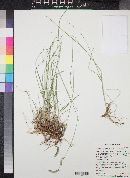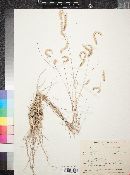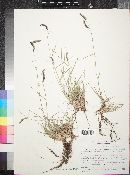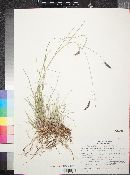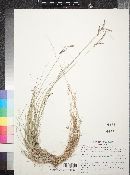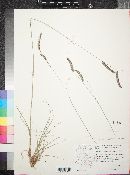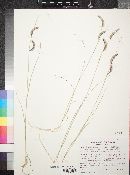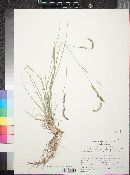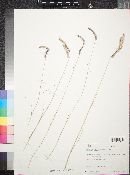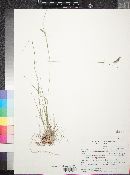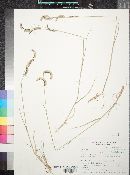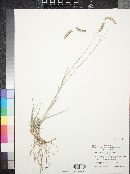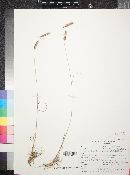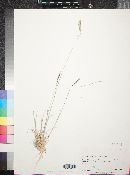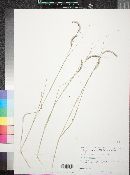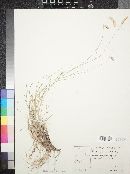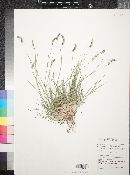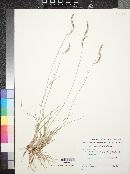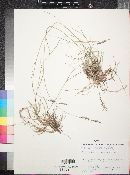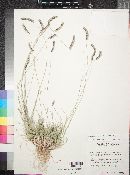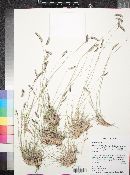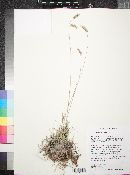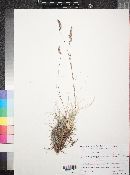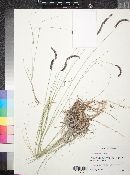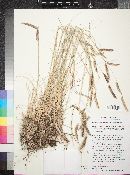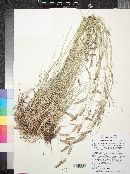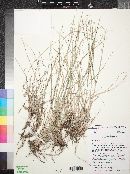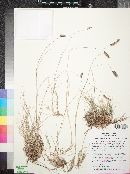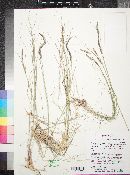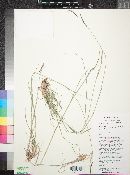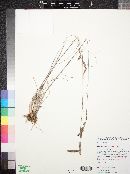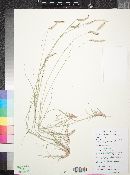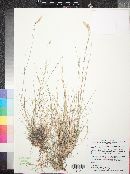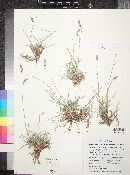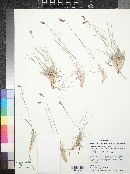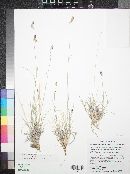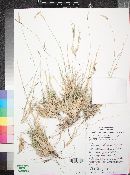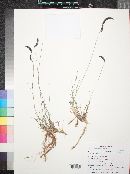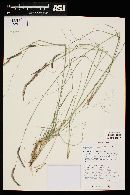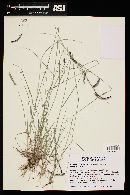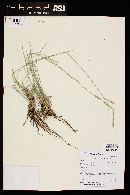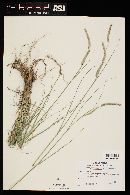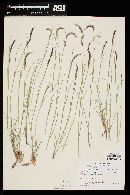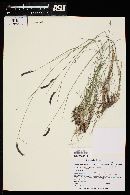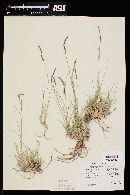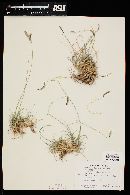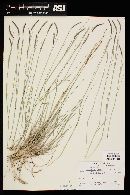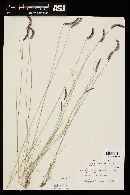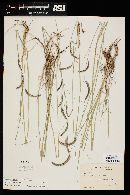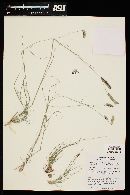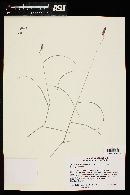
|
|
|
|
Family: Poaceae
Blue Grama, more...Eyelash Grass (es: grama, navajita común)
[Atheropogon gracilis (Kunth) Spreng., moreAtheropogon oligostachyus Nutt., Bouteloua gracilis f. pallida (Scribn. ex Beal) B. Boivin, Bouteloua gracilis var. major (Vasey ex L.H. Dewey) Beetle, Bouteloua gracilis var. stricta (Vasey) A.S. Hitchc., Bouteloua major Vasey, Bouteloua oligostachya (Nutt.) Torr. ex A. Gray, Bouteloua oligostachya var. major Vasey in Vasey, Bouteloua oligostachya var. pallida Scribn. ex Beal, Bouteloua stricta Vasey, Chondrosum gracile Willd. ex Kunth, Chondrosum gracile var. polystachyum Nees, Chondrosum oligostachyum (Nutt.) Torr.] |
Plants perennial; usually densely cespitose, often with short, stout rhizomes. Culms 24-70 cm, not woody basally, erect, geniculate, or decumbent and rooting at the lower nodes, not branched from the aerial nodes; nodes usually 2-3, glabrous or puberulent; lower internodes glabrous. Leaves mainly basal; sheaths glabrous or sparsely hirsute; ligules 0.1-0.4 mm, of hairs, often with marginal tufts of long hairs; blades 2-12(19) cm long, 0.5-2.5 mm wide, flat to involute at maturity, hairs usually present basally. Panicles with 1-3(6) branches, these racemose on 2-8.5(12.5) cm rachises or digitate; branches 13-50(75) mm, persistent, arcuate, scabrous, without papillose-based hairs, with 40-130 spikelets, terminating in a spikelet; disarticulation above the glumes. Spikelets pectinate, with 1 bisexual and 1 rudimentary floret. Glumes mostly glabrous or scabrous, midveins sometimes with papillose-based hairs; lower glumes 1.5-3.5 mm; upper glumes 3.5-6 mm; lowest lemmas 3.5-6 mm, pubescent at least basally, 5-lobed, central and lateral lobes veined and awned, awns 1-3 mm, central awns flanked by 2 membranous lobes; lower paleas about 5 mm, shallowly bilobed, veins excurrent for less than 1 mm; rachilla internodes subtending second florets with a distal tuft of hairs; anthers 1.7-2.9 mm, yellow or purple; upper florets sterile, 0.9-3 mm, lobed almost to the base, lobes rounded, 3-awned, awns equal, 1-3 mm. Caryopses 2.5-3 mm long, about 0.5 mm wide. 2n = 20, 28, 35, 40, 42, 60, 61, 77, 84. Bouteloua gracilis grows in pure stands in mixed prairie associations and disturbed habitats, usually on rocky or clay soils and mainly at elevations of 300-3000 m. Its native range extends from Canada to central Mexico; records from the eastern portion of the Flora represent introductions. Bouteloua gracilis is an important native forage species and also an attractive ornamental. Dr. David Bogler, USDA NRCS PLANTS Database Perennials, Terrestrial, not aquatic, Rhizomes present, Rhizome short and compact, stems close, Stems nodes swollen or brittle, Stems erect or ascending, Stems geniculate, decumbent, or lax, sometimes rooting at nodes, Stems caespitose, tufted, or clustered, Stems terete, round in cross section, or polygonal, Stem internodes hollow, Stems with inflorescence less than 1 m tall, Stems, culms, or scapes exceeding basal leaves, Leaves mostly basal, below middle of stem, Leaves conspicuously 2-ranked, distichous, Leaves sheathing at base, Leaf sheath mostly open, or loose, Leaf sheath smooth, glabrous, Leaf sheath hairy at summit, throat, or collar, Leaf sheath and blade differentiated, Leaf blades linear, Leaf blades very narrow or filiform, less than 2 mm wide, Leaf blades mostly flat, Leaf blade margins folded, involute, or conduplicate, Leaf blades more or less hairy, Ligule present, Ligule a fringe of hairs, Inflorescence terminal, Inflorescence with 2 or more spikes, fascicles, glomerules, heads, or clusters per culm, Inflorescence a panicle with narrowly racemose or spicate branches, Inflorescence with 2-10 branches, Inflorescence branches 1-sided, Inflorescence branches termin ating in bristle or point, Flowers bisexual, Spikelets sessile or subsessile, Spikelets laterally compressed, Spikelet less than 3 mm wide, Spikelets with 1 fertile floret, Spikelets solitary at rachis nodes, Spikelets all alike and fertille, Spikelets bisexual, Spikelets disarticulating above the glumes, glumes persistent, Spikelets secund, in rows on one side of rachis, Rachilla or pedicel glabrous, Glumes present, empty bracts, Glumes 2 clearly present, Glumes distinctly unequal, Glumes equal to or longer than adjacent lemma, Glume equal to or longer than spikelet, Glumes 1 nerved, Lemma coriaceous, firmer or thicker in texture than the glumes, Lemma 3 nerved, Lemma glabrous, Lemma apex dentate, 3-5 fid, Lemma teeth unequal. central tooth longer, Lemma awnless, Lemma with 3 awns, Lemma awn less than 1 cm long, Lemma margins thin, lying flat, Lemma straight, Palea present, well developed, Palea membranous, hyaline, Palea shorter than lemma, Palea 2 nerved or 2 keeled, Stam ens 3, Styles 2-fid, deeply 2-branched, Stigmas 2, Fruit - caryopsis, Caryopsis ellipsoid, longitudinally grooved, hilum long-linear.
Perennial densely tufted herb, often with stout rhizomes 24 cm - 0.9 m tall Leaves: mostly basal, with a hairless or sparesly stiff-haired sheath and a 0.1 - 0.4 mm long ligule that is hairy with long-haired tufts along the margins. The blade is 1 - 19 cm long, 0.5 - 2.5 mm wide, flat or with margins rolling toward the upper surface of the midvein (involute), and usually hairy near the base. Inflorescence: branched (panicle), with one to three (sometimes to six) branches borne on a stalk 2 - 12.5 cm long or arising from a common point (digitate). The arching branches are 1.3 - 7.5 cm long and rough. Fruit: a caryopsis, 2.5 - 3 mm long, about 0.5 mm wide. Culm: 24 cm - 0.7 m long, erect, with abrupt bends at nodes (geniculate), or decumbent and rooting from lower nodes, unbranched at aerial nodes, the two or three nodes hairless or minutely hairy and the lower internodes hairless. Spikelets: 40 to 130 per branch, arranged on one side of the axis, with one spikelet terminating a branch. Glumes: unequal, single-veined, hairless or rough, sometimes having warty-based hairs on the midveins, with the lower glume 1.5 - 3.5 mm long and the upper glume 3.5 - 6 mm long. Florets: two per spikelet, with one bisexual and one poorly developed and sterile. Bisexual florets have yellow or purple, 1.7 - 2.9 mm long anthers. Lemma: of bisexual floret 3.5 - 6 mm long, hairy (sometimes only near base), five-lobed, with the central and outermost lobes veined and awned (1 - 3 mm long) and the other two lobes membranous. The lemma of each sterile floret is 0.9 - 3 mm long, with three equal awns and rounded lobes extending almost to the base. Palea: of bisexual floret about 5 mm long, wtih veins extending less than 1 mm past the end of the palea, absent on sterile floret. Similar species: Bouteloua curtipendula differs by having many more branches (twelve to 80) on a longer stalk (13 - 30 cm) and only one to fifteen spikelets per branch. Bouteloua hirsuta has fewer spikelets per branch (20 to 50) and the branch axis extends beyond the base of the uppermost spikelet. Flowering: July to September Habitat and ecology: Introduced from the western United States, this species is very rare in sand. Occurence in the Chicago region: non-native Etymology: Bouteloua is named after Spanish botanists and brothers, Claudio (1774-1842) and Esteban (1776-1813) Boutelou y Soldevilla. Gracilis means slender. Author: The Morton Arboretum FNA 2003, Gould 1980 Common Name: blue grama Duration: Perennial Nativity: Native Lifeform: Graminoid General: Tufted perennial, semi-sod or ring grass, 25-60 cm tall; smooth or minutely pubescent on the stem nodes; with short, stout rhizomes. Inflorescence: Panicle of 1-4 curved racemose secund branches, bearing 40-130 spikelets per branch; spikelets pectinate and 2-flowered, the lower floret bisexual and the upper rudimentary; disarticulation above the glumes, glumes hairy on midnerve; lowest lemma 3-6 mm long, pubescent basally, 5-lobed, central lobes veined and 3-awned from apical and lateral clefts (1-3 mm long); rachilla with tufts of hair at base of perfect floret. Ecology: Found on open rocky slopes, forest openings, grasslands; 4,000-8,000 ft (1220-2440 m); flowers mostly July-October. Distribution: Most of North America, from CAN south to c MEX. Notes: This is an incredibly common rangeland grass in the Southwest. Diagnostic characteristics include the blue-green leaves which tend to grow in dense tufts and become curly and straw-colored when they dry out; the inflorescence branches which often curl back like an eyelash, especially as the flowers age and dry out; the inflorescence branch rachis (center stalk) is scabrous (rough) on the back and does not extend beyond the last spikelet; and there is a small tuft of hair at the base of the perfect floret within each spikelet. Appears somewhat similar to B. hirsuta, but in that species, the center stalk of each comb-like inflorescence branch extends out beyond the spikelets. Ethnobotany: Roots chewed and blown on cuts; taken as a postpartum medicine; seeds were ground and used to make mush and flour; stems were used to make combs, brooms, and baskets; used as animal fodder; also used ceremonially. Etymology: Bouteloua named for brothers Claudio (1774-1842) and Esteban (1776-1813) Boutelou Agraz, Spanish botanists and horticulturalists; gracilis is Latin for thin, small, or graceful. Synonyms: Bouteloua gracilis var. stricta, B. oligostachya, Chondrosum gracile, C. oligostachyum Editor: SBuckley 2010, FSCoburn 2014, AHazelton 2015 Much like no. 2 [Bouteloua hirsuta Lag.]; lvs curled or flexuous, involute, 1-2 mm wide; rachis not surpassing the uppermost spikelet; second glume 3.5-5 mm, scabrous and sparsely villous on the midvein; fertile lemma densely villous at base and along the midvein, sparsely villous-ciliate, the terminal awn short, the lateral ones 1.5 mm, arising above the middle; vestige stipitate, densely long-villous around the base, bearing 3 rough awns which equal or surpass the second glume; 2n=20-84. Dry prairies and sand-hills; Ill. to Alta., s. to Tex. and s. Calif., and rarely adventive eastward Gleason, Henry A. & Cronquist, Arthur J. 1991. Manual of vascular plants of northeastern United States and adjacent Canada. lxxv + 910 pp. ©The New York Botanical Garden. All rights reserved. Used by permission. |
|
|
|

